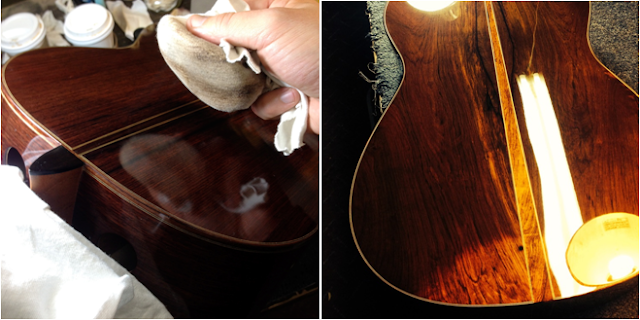Last week we finished this pictured custom Crossover Performance Model instrument for Rick Ellis from San Francisco. As I was playing it and handing it off to it’s new owner, my comment was that this is the new paradigm for a crossover instrument. For Hill Guitar Crossover this is the new standard.

In the decade 2000s we made quite a few Crossover guitars. I think of it as a nylon string guitar aimed at players accustomed to steel string acoustic or electric guitars. Most of those players (then and now) had never played a fine classical guitar, only commercial grade instruments carried as token nylon in general guitar and music stores. There was a trend of electric going acoustic as the “unplugged” movement, and I saw a further opportunity of acoustic going nylon as a further move toward sensitivity. Our Crossover guitar fit the bill. It was basically a normal size classical body with a cutaway, a narrower 48 mm neck. and an arched fingerboard. The decorations were a little more Americana than European, but otherwise the construction was quite traditionally classical.These guitars went over very well, and occasionally one will still pop up here or there, and are still very well loved.
But back then, as the popularity was growing, some big name steel string companies tried developing their own crossover style instruments, and they nearly killed the market. I won’t name names, but I have long contended that nobody can make excellent steel string guitars and excellent nylon string guitars. They’re just different beasts. And in this case I was 100% correct. Those guitars were lumps of wood, no sparkle, no vitality, the only output a nasal buzzing coming from the pickup. Sorry, but it’s true. As they rolled out their nylon string guitars, loyal fans of their brands tried them out, got no love whatsoever from the guitars and said — never mind, I guess nylon sucks. The nylon generation never had a chance, because that market was tainted with mediocre or bad instrument that never really inspired the musicians. I haven’t paid attention to what has happened to those instruments since then, but interest in Crossover guitars within our company really waned. It didn’t really matter to me because we’ve been quite busy enough making concert classical guitars, but as a participant and observer of the market I found that interesting and ironic.
Now, starting at the beginning of this year, a whole new set of custom orders have come through, and many of them variations of the Crossover. Orders and interests do seem to come in waves, but this is a crazy strong trend, from nothing to many in just a few short weeks. My theory is that the quelling effect of all of those disappointing instruments from the 2000's has finally passed through, and that serious musicians and guitar aficionados are again wanting to having a beautiful nylon sound available to them, whether on stage, in the studio or at home.
Nylon strings will never play exactly the same as steel strings. There is only half the tension on the strings, much greater flexibility, and the design of the neck and the top have to take that into account. And for me that is the beauty of it. It’s very sensitive, has so much color and dynamic possibility, and is so user friendly to play.
This particular guitar has rosewood body with spruce/cedar double top, 640mm string length, 12 fret neck with a 48mm (1 7/8") nut width and a 16” radius fingerboard. The body has a sweet little cutaway, one sound port, a wedge tapered body and a wide beveled armrest. Add to this a beautifully natural sounding Barbera pickup and you have a new standard for a Hill Crossover Guitar.
Well, almost. At this point we are only making these guitars as custom orders. Our production is limited and we have a lot of other things to do. But it’s interesting to me, the new appreciation for nylon strings beyond the realm of just classical guitar, and I really like the unique characteristics that are coming out of these instruments. I look forward to hearing all kinds of players making good, new music on them.
Kenny Hill
July 2016


















































